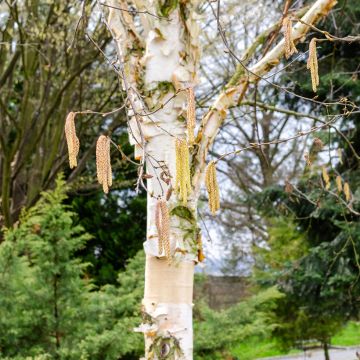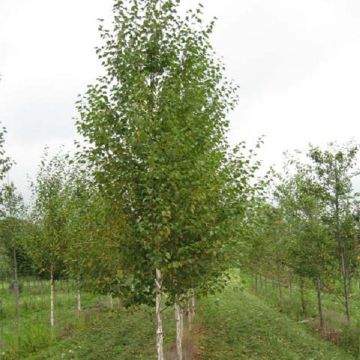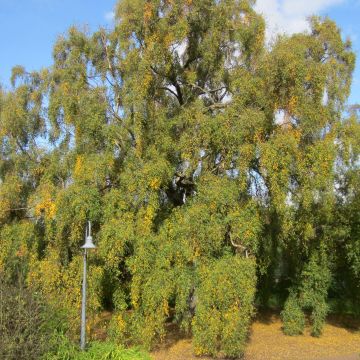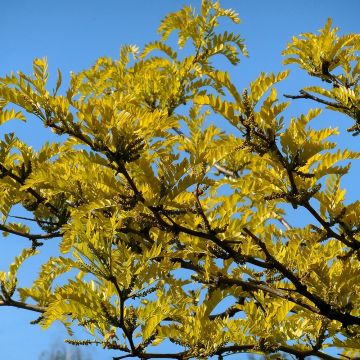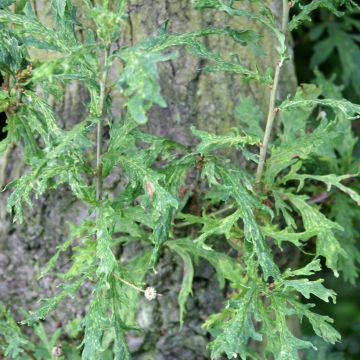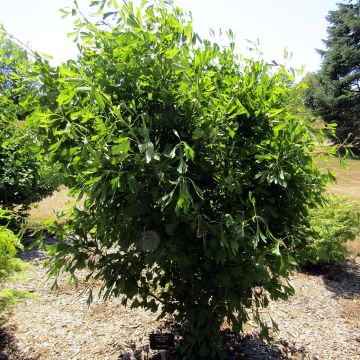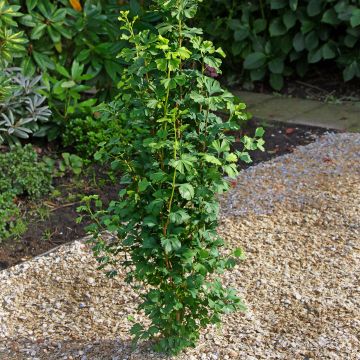

Betula pubescens - Downy Birch
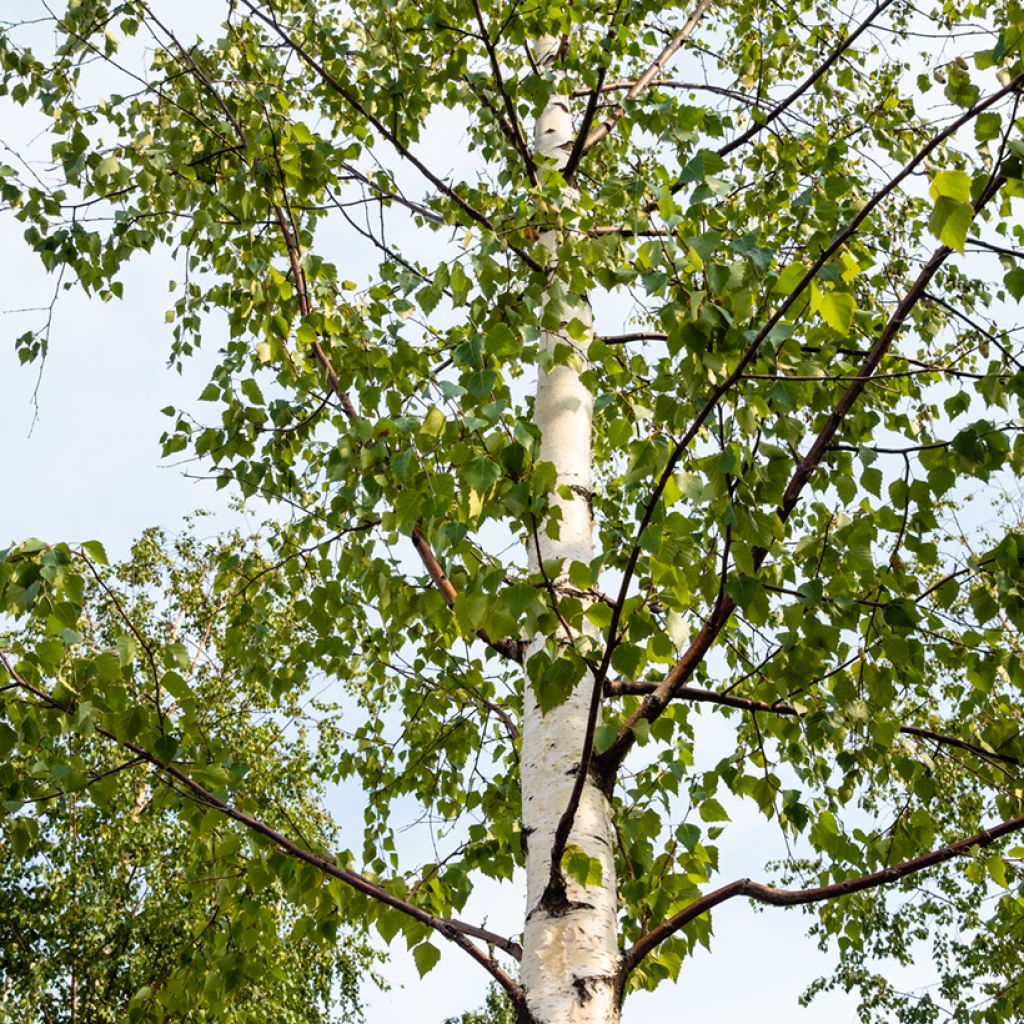

Betula pubescens - Downy Birch


Betula pubescens - Downy Birch


Betula pubescens - Downy Birch
Betula pubescens - Downy Birch
Betula pubescens
Downy Birch
Why not try an alternative variety in stock?
View all →This plant carries a 24 months recovery warranty
More information
We guarantee the quality of our plants for a full growing cycle, and will replace at our expense any plant that fails to recover under normal climatic and planting conditions.
From €5.90 for pickup delivery and €6.90 for home delivery
Express home delivery from €8.90.
Does this plant fit my garden?
Set up your Plantfit profile →
Description
Betula pubescens, commonly known as the Downy Birch, is a species similar to the Warty Birch but distinguished by its smaller size, preference for wetter soils, and duller bark colour. This deciduous tree has an upright, pyramidal habit with a graceful elegance. Its bright green leaves are borne on hairy petioles. In autumn, they turn a warm golden yellow. Fast-growing and not demanding in terms of soil, this hardy birch will thrive particularly well in damp or wet areas of the garden.
Native to mainly central and northern Europe, as well as temperate Asia, the Betula pubescens is a tree of the birch family. Extremely cold-hardy, capable of thriving in acidic and wet as well as sandy, clayey, and limestone soils, it naturally has a pyramidal habit, a more or less straight trunk, and an overall oval, semi-open, airy crown carried by long almost upright branches, with twigs drooping at an acute angle. In the wild, some specimens reach a height of 25m (82ft).
It will typically reach a height of 20m (65ft 7in) with a spread of 10m (32ft 10in). The trunk (sometimes multiple) is covered in brown, smooth bark on young trees. Over time, it becomes white-brown with horizontal stripes, and peels off in flakes. The drooping branches are reddish-brown. The deciduous foliage appears early in spring and is borne on hairy petioles. It consists of diamond-shaped, tender green leaves, 2 to 5cm (0.8 to 2in) long, with simple toothed edges. They turn a beautiful yellow before falling. The inconspicuous flowering in April-May consists of pendulous, yellow-green catkins. The root system of this birch is taproot type, producing radiating lateral main roots with a very dense network of small surface-feeding roots.
The Downy Birch is a tree made for open spaces and light. Superbly structured, its white and slightly drooping branches stand out beautifully against a winter sky. In the garden, it requires no maintenance, is extremely hardy, and not very susceptible to diseases. It deserves a prominent place, either as a solitary tree at the edge of a large garden or at the centre of low shrub borders. It is also well-suited for wet and soggy areas of the garden. To cover the base of this tree, which dries out the soil from spring to summer, it is advisable to choose plants adapted to these conditions like heathers, small grasses like Stipa pennata, Carex, Ophiopogon. It can also be placed in front of a grove of trees chosen for their foliage or decorative bark, such as Acer griseum or Betula albosinensis. Maples, Nysa sylvatica, Chinese mahogany, or white willows will form a superb backdrop for this beautiful tree.
Report an error about the product description
Betula pubescens - Downy Birch in pictures




Plant habit
Flowering
Foliage
Safety measures
Botanical data
Betula
pubescens
Betulaceae
Downy Birch
Central Europe
atteinterespiratoire
Cette plante peut entraîner des symptômes allergiques.
Evitez de la planter si vous ou vos proches souffrez de rhinite saisonnière ("rhume des foins").
Davantage d'informations sur https://plantes-risque.info
Other Betula - Birch tree
Planting and care
Downy Birch is easy to grow, requires little maintenance and can do without pruning. It is best planted in moist to wet soil, low in limestone, humus-bearing and slightly acidic to achieve beautiful foliage colours, but it will also thrive in neutral to slightly limestone soil, in full sun or partial shade. It tolerates clay, loam, sandy, peaty, and nutrient-poor soils that may occasionally dry out. This tree produces numerous superficial roots that can hinder the establishment of other plants beneath its crown, by drying out and depleting the soil. It does not tolerate sea spray well.
Planting period
Intended location
Care
-
, onOrder confirmed
Reply from on Promesse de fleurs
Trees and large shrubs
Haven't found what you were looking for?
Hardiness is the lowest winter temperature a plant can endure without suffering serious damage or even dying. However, hardiness is affected by location (a sheltered area, such as a patio), protection (winter cover) and soil type (hardiness is improved by well-drained soil).

Photo Sharing Terms & Conditions
In order to encourage gardeners to interact and share their experiences, Promesse de fleurs offers various media enabling content to be uploaded onto its Site - in particular via the ‘Photo sharing’ module.
The User agrees to refrain from:
- Posting any content that is illegal, prejudicial, insulting, racist, inciteful to hatred, revisionist, contrary to public decency, that infringes on privacy or on the privacy rights of third parties, in particular the publicity rights of persons and goods, intellectual property rights, or the right to privacy.
- Submitting content on behalf of a third party;
- Impersonate the identity of a third party and/or publish any personal information about a third party;
In general, the User undertakes to refrain from any unethical behaviour.
All Content (in particular text, comments, files, images, photos, videos, creative works, etc.), which may be subject to property or intellectual property rights, image or other private rights, shall remain the property of the User, subject to the limited rights granted by the terms of the licence granted by Promesse de fleurs as stated below. Users are at liberty to publish or not to publish such Content on the Site, notably via the ‘Photo Sharing’ facility, and accept that this Content shall be made public and freely accessible, notably on the Internet.
Users further acknowledge, undertake to have ,and guarantee that they hold all necessary rights and permissions to publish such material on the Site, in particular with regard to the legislation in force pertaining to any privacy, property, intellectual property, image, or contractual rights, or rights of any other nature. By publishing such Content on the Site, Users acknowledge accepting full liability as publishers of the Content within the meaning of the law, and grant Promesse de fleurs, free of charge, an inclusive, worldwide licence for the said Content for the entire duration of its publication, including all reproduction, representation, up/downloading, displaying, performing, transmission, and storage rights.
Users also grant permission for their name to be linked to the Content and accept that this link may not always be made available.
By engaging in posting material, Users consent to their Content becoming automatically accessible on the Internet, in particular on other sites and/or blogs and/or web pages of the Promesse de fleurs site, including in particular social pages and the Promesse de fleurs catalogue.
Users may secure the removal of entrusted content free of charge by issuing a simple request via our contact form.
The flowering period indicated on our website applies to countries and regions located in USDA zone 8 (France, the United Kingdom, Ireland, the Netherlands, etc.)
It will vary according to where you live:
- In zones 9 to 10 (Italy, Spain, Greece, etc.), flowering will occur about 2 to 4 weeks earlier.
- In zones 6 to 7 (Germany, Poland, Slovenia, and lower mountainous regions), flowering will be delayed by 2 to 3 weeks.
- In zone 5 (Central Europe, Scandinavia), blooming will be delayed by 3 to 5 weeks.
In temperate climates, pruning of spring-flowering shrubs (forsythia, spireas, etc.) should be done just after flowering.
Pruning of summer-flowering shrubs (Indian Lilac, Perovskia, etc.) can be done in winter or spring.
In cold regions as well as with frost-sensitive plants, avoid pruning too early when severe frosts may still occur.
The planting period indicated on our website applies to countries and regions located in USDA zone 8 (France, United Kingdom, Ireland, Netherlands).
It will vary according to where you live:
- In Mediterranean zones (Marseille, Madrid, Milan, etc.), autumn and winter are the best planting periods.
- In continental zones (Strasbourg, Munich, Vienna, etc.), delay planting by 2 to 3 weeks in spring and bring it forward by 2 to 4 weeks in autumn.
- In mountainous regions (the Alps, Pyrenees, Carpathians, etc.), it is best to plant in late spring (May-June) or late summer (August-September).
The harvesting period indicated on our website applies to countries and regions in USDA zone 8 (France, England, Ireland, the Netherlands).
In colder areas (Scandinavia, Poland, Austria...) fruit and vegetable harvests are likely to be delayed by 3-4 weeks.
In warmer areas (Italy, Spain, Greece, etc.), harvesting will probably take place earlier, depending on weather conditions.
The sowing periods indicated on our website apply to countries and regions within USDA Zone 8 (France, UK, Ireland, Netherlands).
In colder areas (Scandinavia, Poland, Austria...), delay any outdoor sowing by 3-4 weeks, or sow under glass.
In warmer climes (Italy, Spain, Greece, etc.), bring outdoor sowing forward by a few weeks.



































